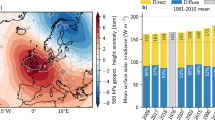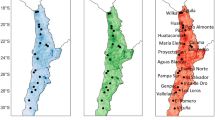Abstract
MONITORING of solar radiation at the Mauna Loa Observatory is part of a benchmark programme which was initiated at the beginning of the International Geophysical Year on January 1, 1958. The geographic and topographic location of the Observatory greatly enhances the quality of the measurements. At an elevation of 3.4 km, the optical path is reduced to about two-thirds of its magnitude at sea level, and at a latitude of 19.32° N, the Sun at solar noon is almost vertically overhead with a zenith angle of less than 4° on 125 consecutive days annually. Hawaii's location, generally upwind of the other islands of the Hawaiian chain and about 3,700 km from the nearest continent, assures that only longlived substances from any but local sources can affect the solar radiation monitored on Mauna Loa. Perturbations of atmospheric opacities from local sources are minimized by a 30 km distance from only sparsely populated civilization centres and the absence of heavy industries anywhere on the island. Frequent orographic rainfalls (about 400 cm annually) to the windward and over existing pollution sources provide a natural cleansing mechanism. The marine trade inversion is usually found below the elevation of the Observatory and traps most of the particulate matter emitted into the atmosphere from local terrestrial sources. Finally, during several hours after sunrise, the monitoring site is exposed to dry, clean descending air from higher elevations in the course of a thermally induced diurnal mountain circulation.
This is a preview of subscription content, access via your institution
Access options
Subscribe to this journal
Receive 51 print issues and online access
$199.00 per year
only $3.90 per issue
Buy this article
- Purchase on Springer Link
- Instant access to full article PDF
Prices may be subject to local taxes which are calculated during checkout
Similar content being viewed by others
References
Peterson, J. T., and Bryson, R. A., Science, 162, 120 (1968).
Ellis, H. T., and Pueschel, R. F., Science, 172, 845 (1971).
Viebrock, J. H., and Flowers, E. C., Tellus, 20, 400 (1968).
Volz, F. E., J. Geophys. Res., 75, 5158 (1970).
Cronin, J. F., Science, 172, 847 (1971).
Flowers, E. C., McCormick, R. A., and Kurfis, Y. R., J. Appl. Meteor., 8, 955 (1969).
Weinberg, J. L., Proc. ASTRA Symp.
Roosen, R. G., and Augione, R. J., Proc. ASTRA Symp.
Author information
Authors and Affiliations
Rights and permissions
About this article
Cite this article
PUESCHEL, R., MACHTA, L., COTTON, G. et al. Physical Sciences: Normal Incidence Radiation Trends on Mauna Loa, Hawaii. Nature 240, 545–547 (1972). https://doi.org/10.1038/240545a0
Received:
Issue Date:
DOI: https://doi.org/10.1038/240545a0
This article is cited by
-
Interpretation of Mauna Loa atmospheric transmission relative to aerosols, using photometric precipitable water amouts
Journal of Atmospheric Chemistry (1985)
Comments
By submitting a comment you agree to abide by our Terms and Community Guidelines. If you find something abusive or that does not comply with our terms or guidelines please flag it as inappropriate.



